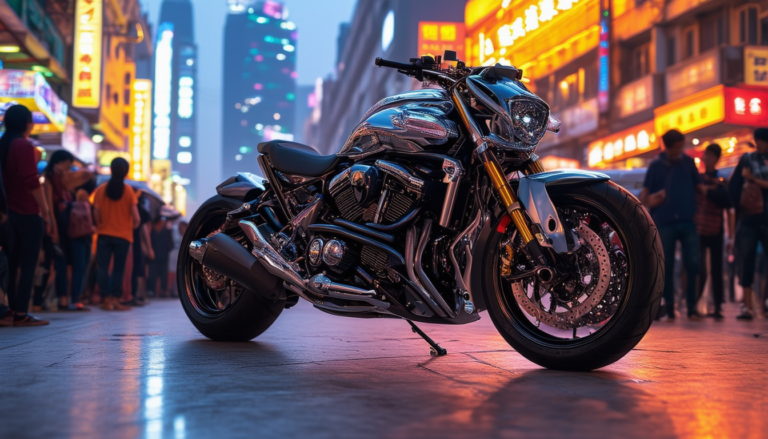Has Honda Just Unveiled a Turbocharged Motorcycle Engine?

Recently, Honda made waves in the motorcycle industry with the unveiling of an innovative engine that has sparked discussions among enthusiasts. This new addition features a three-cylinder engine in a 75-degree V3 configuration paired with what the manufacturer describes as the world’s first electrical compressor for motorcycles. While technically not a turbocharger, this development promises to enhance power and torque, particularly at low RPMs. As bike manufacturers adapt to changing emissions standards, Honda’s new engine could represent a significant shift in motorcycle engineering and performance.
Honda has recently made headlines with the reveal of their latest motorcycle engine, a groundbreaking development featuring a three-cylinder configuration and what they are calling the world’s first electric compressor for motorcycles. This innovative setup has sparked discussions about whether it can be classified as a turbocharged engine, given its unique specifications and performance attributes. Let’s delve into the details of this machine and the potential ramifications for the motorcycle industry.
Understanding the New Engine Design
The newly introduced V3 engine adopts a 75-degree configuration with two cylinders at the front and one positioned in the rear, effectively creating a balanced layout. This innovative design enhances power delivery and responsiveness. A notable feature of this engine is the electric compressor, which promises to boost power and torque at low RPMs without relying on conventional exhaust gases like traditional turbochargers.
The Role of the Electric Compressor
The electric compressor is compactly designed, located above the engine and beneath where the fuel tank typically resides. One of its primary advantages is that it doesn’t require an intercooler, which is a common necessity for turbochargers aiming to reduce air temperature entering the engine. By eliminating the need for bulky intercooler components, Honda has managed to devise a system that not only saves weight but also simplifies the engine’s overall architecture, potentially changing the landscape for motorcycle performance.
Production Possibilities for the V3 Engine
Speculation surrounding the potential production of this engine is gaining traction. Honda has indicated that this engine is being developed specifically for larger displacement motorcycles, suggesting it could replace existing four-cylinder engines found in models like the CBR1000RR or the CB1000R. These new powerplants would likely lead to a rebranding of these models while maintaining their intended performance levels, as highlighted by the accompanying imagery of sport bike wheels in Honda’s release.
Why Move to a V3 Configuration?
The shift to a V3 engine with an electric compressor comes as the motorcycle industry grapples with evolving global emissions standards. As regulations tighten, manufacturers are reconsidering their engine designs to reduce cylinder counts and improve efficiency. Major players like Yamaha are already transitioning from four-cylinder engines to two and three-cylinder alternatives, making it plausible for Honda to follow suit. A torquey V3 engine could serve to balance high power outputs with compliance to stricter environmental regulations.
Honda has recently introduced an innovative motorcycle engine that has caught the attention of enthusiasts and industry experts alike. This new engine features a 75-degree V3 configuration and boasts what is termed as the world’s first electric compressor specifically designed for motorcycles. Unlike traditional turbochargers, this technology aims to enhance power and torque at low RPMs, thus promising an exciting shift in motorcycle performance.
The Innovative Electric Compressor
At the heart of this new development is the compact electric compressor placed strategically above the engine. This setup eliminates the need for an intercooler, making it less bulky and more efficient compared to conventional systems, which often require extensive piping and separate cooling components. This design could revolutionize how we think about motorcycle engine configurations and performance standards.
Production Potential
There is a strong indication that this V3 engine will make its way into production motorcycles. Honda’s commitment to further developing this engine for larger displacement models suggests that it could replace existing four-cylinder engines in popular bikes. This shift in production strategy could redefine Honda’s lineup, paving the way for more advanced models that cater to modern performance standards while adhering to global emissions regulations.
The Emissions Challenge
As environmental regulations evolve, motorcycle manufacturers face the challenge of minimizing emissions while maximizing performance. By embracing a V3 engine configuration, Honda may align itself with industry trends to reduce cylinder counts without compromising on the fun-to-ride experience that many sport motorcycle enthusiasts cherish. This move could set the standard for the future of high-performance motorcycles.
Why Choose a V3 Engine?
The adoption of a V3 engine with an electric compressor could deliver the exhilarating speed and power that sport bikers expect, while also offering a more compact design. The potential for greater torque at lower RPMs makes this engine configuration appealing, especially as manufacturers look to meet evolving consumer desires for both performance and efficiency. It will be interesting to see whether Honda’s innovation will spur competitors to explore similar technologies in their upcoming models.






